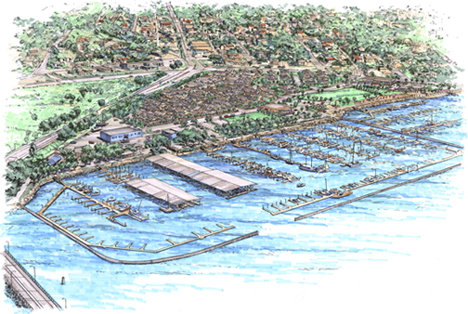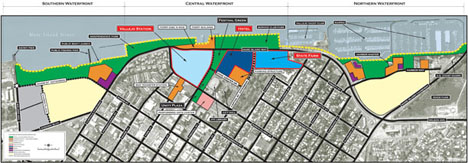A major development, forever in the planning, would be a boon for Vallejo ferry riders, and anyone else interested in improving that underappreciated city’s quality of life. Determined opponents are trying to block it and all the good it would bring, citing the need for more open space.

Vallejo’s Billion Dollar Tidal Wave of Redevelopment Deficit
By Wes Starratt, Senior Editor
Published: June, 2005
The City of Vallejo is facing a tidal wave of more than one billion dollars in redevelopment projects that will transform it into the vibrant and dynamic center of the region. It all began with the doom and gloom created by the closing of the Mare Island Naval Shipyard in the early 1990s, followed by the lengthy preparation and approval of a reuse plan, and extended negotiations with the Navy. Today, Mare Island has turned the corner as Lennar moves ahead with several projects, including the redevelopment of a 653-acre parcel in the center of Mare Island. Vallejo’s city manager, Roger Kemp commented enthusiastically, “We have received the Environmental Impact Report (EIR) on the project. That train is on the track and going full speed. They have approval for 1400 homes and townhouses, and Phase One is already 40% sold out. We also have the Downtown Redevelopment Project, with about 1000 units, and the Waterfront Project, which has another 1000 units. That will bring 4,000 people to downtown Vallejo in the next decade.” Together, these projects add up to more than $1 billion … with a “b” … in construction work that will take place in Vallejo and Mare Island over the next decade … quite an achievement for a city with a population of only 120,000!
Waterfront and the Ferries
Vallejo’s waterfront has always been the focal point of the city, but after World War II, the area sank into decay. But, a massive federal urban renewal program of the early 1960s put an end to that, removing the blight and transforming the waterfront into a vast open space between Mare Island Strait and Vallejo’s civic center complex.
Ferry service to Vallejo, operated by Red & White Fleet, started up shortly after the opening of Marine World/Africa USA in 1986, and eventually led to the city’s establishment of its very successful Baylink Ferries, along with the construction of the magnificent $1.2-million Ferry Terminal with the adjacent $1.7 million high-capacity passenger float and gangway. That ferry service, together with its feeder bus service, has transformed Vallejo into the transportation hub of the North Bay.
The Redevelopment Program
In spite of the popularity of the ferries, or maybe because of their popularity, the waterfront remained a vast undeveloped open space. This valuable land obviously had to be put to more productive use. On weekdays, it was a vast sea of parked automobiles belonging to ferry commuters. On the weekends it was empty. We talked with Leah Dreger, the DeSilva group’s manager of the Waterfront Redevelopment Project, who pointed out, “It was the ferry service that got the waterfront development started. We saw, and the city saw, that there is a great deal of valuable real estate caught up in parking for the ferry. In reality, the ferry service was gobbling up prime real estate that could be put to better use.” So, Vallejo Station, a parking and multi-modal bus transfer facility, became the cornerstone of the Waterfront Development Project that the city spear-headed in order to get surface parking underground and free-up waterfront acreage for development.
In 1997, the Vallejo Redevelopment Agency issued a request for proposals for the Waterfront Redevelopment Project, comprising the Vallejo Station Project (for ferry passengers) and Waterfront development. Early in 1998, the DeSilva Group was selected by the city as the Master Waterfront Developer. Headed by paving-contractor Edwin DeSilva, the group was well known in Vallejo since it had recently completed two housing developments in the city. DeSilva subsequently teamed up with Callahan Property Company, which is known for its Hacienda Business Park in Pleasanton, and the city’s Redevelopment Agency to form the development group, Callahan/DeSilva Vallejo LLC.
The Project
The Waterfront Redevelopment Project comprises 110 acres along Mare Island Strait, between the Mare Island Causeway on the north and Solano Avenue on the south. According to project manager Leah Dreger,“it is a large and complicated project,” which is certainly an understatement for a project requiring 10 years of planning, development and construction, together with a lot of up-front money.
Completion of the entire $400-million project is expected to take 10 years, commencing with an initial 3-year planning process, which has involved the development of a waterfront master plan in 1999; a master plan for open space in 2000; and a transportation facility location and design study in 2001. Those plans and studies led to the preparation of a draft Environmental Impact Report (EIR), followed by public hearings, and the preparation of a Revised EIR.
That Revised EIR is expected to be completed by June 1 of this year, followed by a 60-day public review period. Certification of the EIR is expected to be considered by the Vallejo City Council in October, along with the required approvals for the project. Reviews and permits will be needed not only from the city, but also an array of regulatory agencies that include the Bay Area Regional Water Quality Control Board, the Bay Conservation and Development Commission, the State Lands Commission, Caltrans, the Metropolitan Transportation Commission, and more.
After all of these preliminaries are concluded, construction can actually begin, possibly by next year. But, it is essential that the project be phased in a proper sequence so that the initial phases can provide the cash flow needed for the subsequent phases. Thus, construction is expected to start with at least some of the housing and commercial phases, which will provide a cash flow for the developer and tax revenue for the city to fund the subsequent elements of the project that will include Vallejo Station and open space.
The City of Vallejo’s Redevelopment Projects include:
• 35 acres for Vallejo Station, which will comprise 1,200 automobile spaces, to consolidate ferry parking and a bus transfer point or so-called “multi-modal facility,” together with a residential component, or “transit village,”
• 28 acres for parks, open space, plazas, and promenades
• 50 acres to be used for 562,000 square feet of retail/commercial/office space and 1,080 residential units, ranging from condominiums to attached units, plus a hotel, conference center, and a performing arts center.


